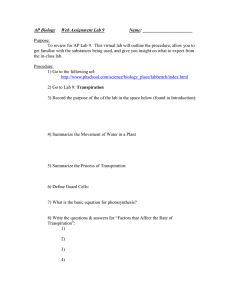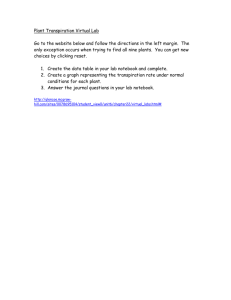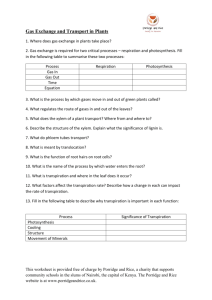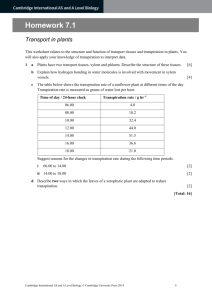Lesson Plan Blank-Transpiration - OISE-IS-BIOLOGY-2011-2012
advertisement
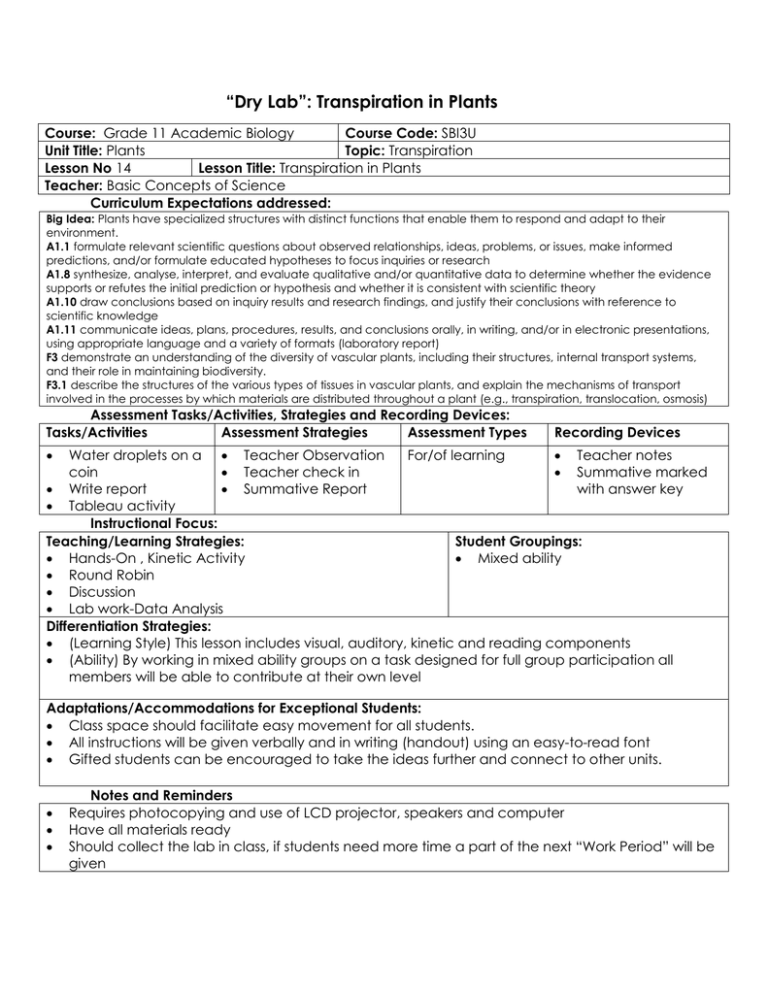
“Dry Lab”: Transpiration in Plants Course: Grade 11 Academic Biology Course Code: SBI3U Unit Title: Plants Topic: Transpiration Lesson No 14 Lesson Title: Transpiration in Plants Teacher: Basic Concepts of Science Curriculum Expectations addressed: Big Idea: Plants have specialized structures with distinct functions that enable them to respond and adapt to their environment. A1.1 formulate relevant scientific questions about observed relationships, ideas, problems, or issues, make informed predictions, and/or formulate educated hypotheses to focus inquiries or research A1.8 synthesize, analyse, interpret, and evaluate qualitative and/or quantitative data to determine whether the evidence supports or refutes the initial prediction or hypothesis and whether it is consistent with scientific theory A1.10 draw conclusions based on inquiry results and research findings, and justify their conclusions with reference to scientific knowledge A1.11 communicate ideas, plans, procedures, results, and conclusions orally, in writing, and/or in electronic presentations, using appropriate language and a variety of formats (laboratory report) F3 demonstrate an understanding of the diversity of vascular plants, including their structures, internal transport systems, and their role in maintaining biodiversity. F3.1 describe the structures of the various types of tissues in vascular plants, and explain the mechanisms of transport involved in the processes by which materials are distributed throughout a plant (e.g., transpiration, translocation, osmosis) Assessment Tasks/Activities, Strategies and Recording Devices: Tasks/Activities Assessment Strategies Assessment Types Recording Devices Water droplets on a Teacher Observation For/of learning Teacher notes coin Teacher check in Summative marked Write report Summative Report with answer key Tableau activity Instructional Focus: Teaching/Learning Strategies: Student Groupings: Hands-On , Kinetic Activity Mixed ability Round Robin Discussion Lab work-Data Analysis Differentiation Strategies: (Learning Style) This lesson includes visual, auditory, kinetic and reading components (Ability) By working in mixed ability groups on a task designed for full group participation all members will be able to contribute at their own level Adaptations/Accommodations for Exceptional Students: Class space should facilitate easy movement for all students. All instructions will be given verbally and in writing (handout) using an easy-to-read font Gifted students can be encouraged to take the ideas further and connect to other units. Notes and Reminders Requires photocopying and use of LCD projector, speakers and computer Have all materials ready Should collect the lab in class, if students need more time a part of the next “Work Period” will be given Lesson Outline Objectives (learning goals): By the end of the class students will be able to understand the cohesive and adhesive properties in relation to water transport. By the end of class students will be able to clearly explain the process of transpiration in relation to anatomical features and environmental conditions. Supply each group with 2 pennies 10 Initiate predicting how many drops of water and soapy water you can fit on a coin? Minds On Distribute handout and go over instructions verbally 50 When groups have finished the activity they should discuss among themselves what happened and why they think it happened Whole class discussion on cohesive and adhesive properties of water Watch this Ray Smears video on transpiration in a desert: http://www.youtube.com/watch?v=vxB61tGEur Materials and Resources Required 2 pennies/group 1 dropper/group 1 beaker with water/group 1 beaker with water and soap/group Safety goggles Paper towels to clean up Student handouts Computer, speakers and LCD Projector Graph Paper and rulers 5 Next Steps 10 Consolidation and Debrief Action Address any gaps in knowledge from Minds on and video Distribute lab handout and graph paper and go over instructions verbally and visually by having students explore this virtual lab simulation: http://www.mhhe.com/biosci/genbio/virtual_labs/BL_10 /BL_10.html Students will complete the transpiration lab in class Identify new vocabulary for the word wall; one student will write the new vocabulary on the word wall. Class: Work Period Key Vocabulary Adhesion Cohesion Water Concentration Transpiration Drops on a Penny During this activity you will be using a dropper to place drops of water and soapy water on a penny (one at a time). You will count the drops of water until ANY amount of water runs over the edge of the penny. Then in a circle, you will each have a turn to discuss your observations with your group and be prepared to take them up with the rest of the class. Please follow the instructions below. 1. Gather all materials. a. Two pennies b. A beaker of water c. A beaker of soapy water d. A dropper e. Paper towel f. Safety goggles 2. Put on goggles 3. Set the penny face up on the paper towel. 4. Use the dropper to add as many drops of water as you can without spilling water off the sides. 5. Record the amount of drops it took to make the water spill 6. Repeat steps 2-4 and record the number of water drops. 7. Now repeat steps 2-5 for soapy water Predict: Observed: Explain: Water Soapy Water Discussion Notes: What happened and propose a reason for this? Why might the properties of water be helpful for water transport in the plants xylem? Drops on a Penny – Teacher Copy During this activity you will be using a dropper to place drops of water and soapy water on a penny (one at a time). You will count the drops of water until ANY amount of water runs over the edge of the penny. Then in a circle, you will each have a turn to discuss your observations with your group and be prepared to take them up with the rest of the class. Please follow the instructions below. Organize groups of 3-4 1. Gather all materials. a. Two pennies – to distribute at the beginning of class b. A beaker of water 1 student representative can get this for the c. A beaker of soapy water group d. A dropper e. Paper towel Another student representative can get these f. Safety goggles 2. Put on goggles –the soap can sting students eyes 3. Set the penny face up on the paper towel. 4. Use the dropper to add as many drops of water as you can without spilling water off the sides. 5. Record the amount of drops it took to make the water spill 6. Repeat steps 2-4 and record the number of water drops. 7. Now repeat steps 2-5 for soapy water – circulate to each group and note any preconceived ideas Predict: Observed: Explain: Water Many possible answers Usually above 30 drops Many possible student answers Soapy Water Many possible answers Should be significantly less than amount of water drops Many possible student answers Discussion Notes: What happened and propose a reason for this? Have one person from each group share their groups’ ideas What happens- The drops “stick” to each other on the penny and more drops of water can fit than soapy water. Why this happens-Water is a polar molecule and forms hydrogen bonds. The polar water molecules hold on to the surface of the penny that is polar, this is known as adhesion. The hydrogen bonding allows water molecules to stick to other water molecules, this is known as adhesion. Why might the properties of water be helpful for water transport in the plants xylem? Adhesion can allow the water molecules to hold onto the thin xylem vessels and cohesion can allow water molecules to pull each other in the xylem similar to beads on a string. Plant Transpiration Lab Introduction: Transpiration is the evaporation of water from plants, it occurs when the stomata of the leaves are open. Since a leaf needs carbon dioxide and water for photosynthesis the plant must strike a balance between conserving water and bringing in sufficient amounts of carbon dioxide for photosynthesis. The transport of water is controlled by water concentration. Water moves from a high water concentration to a low water concentration. Transpiration from the leaf sets up a water concentration gradient that has an upward pull on water and is the major mechanism that pulls water through the xylem vascular tissue. This pull is increased by water’s natural properties of adhesion and cohesion. Below is a diagram of a tree. With a ruler, show the direction of transpiration and indicate the area of low water concentration and high water concentration. Purpose: Various factors can affect the rate of transpiration. We will be analyzing how the amount of light, temperature, humidity, and wind can affect the rate of transpiration in plants. Hypothesis: What do you think will happen? (1 sentence for each factor) Light: _______________________________________________________________________ Temperature: ________________________________________________________________ Humidity: ____________________________________________________________________ Wind: ________________________________________________________________________ Method: 1. Five geranium plants were grown under different environmental conditions. The conditions were as follows: a. Average room b. Bright Lamp: to test light c. Heater: to test temperature d. Mist: to test humidity e. Fan: to test wind 2. Every three minutes, the water loss was measured in ml/m2 and recorded. What is the control in this lab? _______________________________________________________ Observations: Below are the results of the experiment measured in ml/m2. Table 1: Total Water Loss for different Environmental Conditions in mL/m2 Time (min) 3 6 9 12 15 Average Room 0.2 0.4 0.6 0.8 1 Bright Lamp 0.29 0.57 1.01 1.44 1.72 Heater 0.3 0.61 0.94 1.3 1.65 Mist 0.13 0.26 0.39 0.52 0.64 Fan 0.25 0.49 0.74 1.1 1.35 18 1.1 2.01 1.91 0.77 1.96 21 1.3 2.3 2.21 0.9 2.33 Analysis: 1. Propose an explanation for the calculation of leaf surface area. ________________________________________________________________________ ________________________________________________________________________ 2. Create a graph based on the set of values from the observations in the provided chart paper. 3. From the graph calculate the overall rate of transpiration (per minute) for each condition. ________________________________________________________________________ ________________________________________________________________________ ________________________________________________________________________ ________________________________________________________________________ ________________________________________________________________________ Conclusion: What is the relationship of each of these factors to transpiration? Explain which factor had the greatest effect on the rate of transpiration? ________________________________________________________________________ ________________________________________________________________________ ________________________________________________________________________ ________________________________________________________________________ ________________________________________________________________________ ________________________________________________________________________ Discussion: Explain why different species of plants may transpire at different rates. How does the process of transpiration relate to agriculture, or climate change? (Pick one) ________________________________________________________________________ ________________________________________________________________________ ________________________________________________________________________ ________________________________________________________________________ ________________________________________________________________________ ________________________________________________________________________ ________________________________________________________________________ Plant Transpiration Lab-Teacher Handout Introduction: Transpiration is the evaporation of water from plants, it occurs when the stomata of the leaves are open. Since a leaf needs carbon dioxide and water for photosynthesis the plant must strike a balance between conserving water and bringing in sufficient amounts of carbon dioxide for photosynthesis. The transport of water is controlled by water concentration. Water moves from a high water concentration to a low water concentration. Transpiration from the leaf sets up a water concentration gradient that has an upward pull on water and is the major mechanism that pulls water through the xylem vascular tissue. This pull is increased by water’s natural properties of adhesion and cohesion. The properties of water were explained in the prior minds-on activity. Below is a diagram of a tree. With a ruler, show the direction of transpiration and indicate the area of low water concentration and high water concentration. Circulate around the class to check students are on the right track. Low Water Concentration High Water Concentration Purpose: Various factors can affect the rate of transpiration. We will be analyzing how the amount of light, temperature, humidity, and wind can affect the rate of transpiration in plants. Hypothesis: What do you think will happen? (1 sentence for each factor) An increase/decrease in factor will increase/decrease the rate of transpiration. Light: _______________________________________________________________________ Temperature: ________________________________________________________________ Humidity: ____________________________________________________________________ Wind: ________________________________________________________________________ Method: 1 Five geranium plants were grown under different environmental conditions. The conditions were as follows: a. Average room b. Bright Lamp: to test light c. Heater: to test temperature d. Mist: to test humidity e. Fan: to test wind 2. Every three minutes, the water loss was measured in ml/m2 and recorded. What is the control in this lab? _Average room_______________________________________ Observations: Below are the results of the experiment measured in ml/m2. Table 1: Total Water Loss for different Environmental Conditions in mL/m2 Time (min) 3 6 9 12 15 Average Room 0.2 0.4 0.6 0.8 1 Bright Lamp 0.29 0.57 1.01 1.44 1.72 Heater 0.3 0.61 0.94 1.3 1.65 Mist 0.13 0.26 0.39 0.52 0.64 Fan 0.25 0.49 0.74 1.1 1.35 18 1.1 2.01 1.91 0.77 1.96 21 1.3 2.3 2.21 0.9 2.33 Analysis: 1. Propose an explanation for the calculation of leaf surface area. To assist exceptional students prompt them with a hint on the number of stomata. Answer: The stomata on the leaves of a plant regulate transpiration. Therefore the bigger the surface area, the more water vapor lost from the plant. A misconception is that the stomata number is the same for all species of plants. Create a graph based on the set of values from the observations in the provided chart paper. 2. From the graph calculate the overall rate of transpiration (per minute) for each condition. To assist exceptional students provide the hint to look at the slope of the line of best fit. This is the last unit, students will have had prior experience on calculating the rate from a graph. Rate of Transpiration in Different Environment Conditions 2.5 Average Room Water Loss in mL/m2 2 Bright Lamp Heater 1.5 Mist 1 Fan Linear (Average Room) 0.5 Linear (Bright Lamp ) 0 0 5 10 15 Time (minutes) 20 25 Linear (Heater) Linear (Mist ) Conclusion: What is the relationship of each of these factors to transpiration? Explain which factor had the greatest effect on the rate of transpiration? Answer: For the geranium plant the rate of transpiration increased as the light, temperature, and wind increased and the rate of transpiration decreased as the humidity increased. The fan which simulated wind had the greatest effect on the rate of transpiration as the slope of the graph was the steepest. Discussion: Explain why different species of plants may transpire at different rates. How does the process of transpiration relate to the water conservation, or air pollution? (Pick one) Gifted students can explain both. Multiple Answers: Thinking about adding these two graphs to analyze: 1 no water limitation stomates open 2 some water limitation midday stomatal regulation 3 severe water limitation midday stomatal closure 4 soil dry complete stomatal closure
